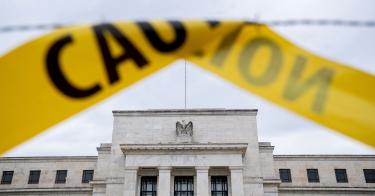The Federal Reserve has become borderline schizophrenic and downright destructive toward the American people. First, it created trillions of dollars to feed the government’s out-of-control spending, bringing sky-high inflation. Now, in an attempt to fix the inflation problem, it has chosen to go after the American people instead of cutting off the government from its credit addiction. It’s time for the Fed to be reined in.
After two years of punishingly high inflation, the economy is now poised for a double-dip recession. American families, having seen their wages and savings lose about 14% of their value, face the prospect of coming layoffs. We are seeing, in real time, the effects of not just excessive government spending but what helped enable it: the Fed’s violent policy swings.
Anyone who has driven too fast in slick conditions has likely experienced a similar overcorrecting. If you steer a vehicle too sharply in one direction and cause a skid, you need to quickly steer in the opposite direction to correct it. But overdoing it can create a worse skid in the opposite direction. The pattern then repeats with each skid growing increasingly violent until the vehicle spins out of control.
When the economy skidded during the pandemic in early 2020, the Fed threw its printers into overdrive and flooded the economy with money in the hopes of easing the short recession that resulted from government-imposed shutdowns. It took interest rates to zero so that consumers and borrowers alike had access to plenty of credit to tide everyone over until the economy reopened.
And that’s where the story should’ve ended. But the Fed continued creating money for two full years, mostly giving it to the Treasury through the purchase of bonds to cover the record-breaking deficit spending passed by Congress.
The continued flood of money spurred on malinvestment and misallocations of resources across the economy. Consumers were able to get massive mortgages that would normally have been unaffordable, investors plowed excess savings into stocks, and businesses borrowed heavily to stock up on inventories, build new plants, and buy new equipment.
All those things sound good at first, and, sure enough, the economy appeared to experience healthy growth. But then the Fed’s overcorrection became painfully evident as the economy skidded into the wall of inflation.
After the Fed created trillions of dollars for the government to spend, there is now too much money relative to the size of the economy. Consumers, businesses, and the government have too much money chasing too few goods and services, and the result is much higher prices.
To bring inflation under control, the Fed needs to reduce the amount of money in the economy. The logical place to reel in those dollars would be the government, since that’s where the newly created money went in the first place. The Fed could accomplish this by selling off trillions of dollars in Treasury bonds and letting interest rates seek their natural level.
But that would also force the Treasury to auction all its new bonds to the private market since the Fed wasn’t buying them, and the private market would require much higher bond yields at auction. Higher bond yields would drastically raise borrowing costs for the Treasury and make current government spending levels prohibitively expensive.
That’s a position the Fed and its government allies don’t seem to want to be in. So, instead of reining in the government sector, the central bank instead is turning to the American people for its pound of flesh. The Fed is raising interest rates, increasing borrowing costs for consumers and businesses alike. Higher financing costs from tighter credit conditions mean less investment by businesses and less spending by consumers, which can lead to layoffs and job losses.
Thus, the private sector economy slows as the Fed violently turns the vehicle in the other direction, in a fateful act of overcorrecting, throwing the economy into the wall of recession.
Ultimately, the Fed’s monetary manipulations vampirically transfuse wealth from the American people to the government while making the business cycle of booms and busts worse by oscillating back and forth between steering the economy in one direction and then the other.
Why is this happening?
The Fed’s bipolar monetary policy is explained by what is commonly referred to as its “dual mandate” to promote both full employment and price stability (keeping inflation in check). The dual mandate is also the excuse by which the Fed swerves toward inflation and fueling government spending in the name of promoting full employment. It mistakenly acts as if producing inflationary pressure by creating money for the government to spend will create a growing economy and more jobs during a recession.
But even if the Fed were theoretically capable of countering the business cycle (reducing job losses during recessions and reducing inflation during expansions), it has time and again failed to successfully conduct discretionary monetary policy.
There are two reasons why.
First, Fed policy has a lag, meaning its effects are not felt until some time after its implementation—often months. To determine what today’s interest rate policy should be actually requires knowledge of future conditions—an impossibility. Thus, the Fed is doomed to mistime its attempts.
Second, there is a political incentive to time interest rate decisions for the benefit of politicians. Despite a veil of independence, the Fed has lost credibility as a nonpolitical institution.
The solution is for Congress to remove this dual mandate from the Fed so that its only goals are price stability and the moderation of long-term interest rates, not promoting full employment.
Thus, when the government wants to spend money it doesn’t have, the Fed would have no excuse to create the money for the Treasury and thereby cause rampant inflation. And by removing an artificial boom from overspending, the subsequent bust is also eliminated, smoothing out the fluctuations of the business cycle instead of exacerbating them.
The Fed’s dual mandate is a perfect example of government institutions growing beyond their original size and scope, creating disastrous results. The last two years, and possibly the next two as well, are evidence enough that the dual mandate of the Fed is best left to the ash heap of history.
This piece originally appeared in The Daily Signal




